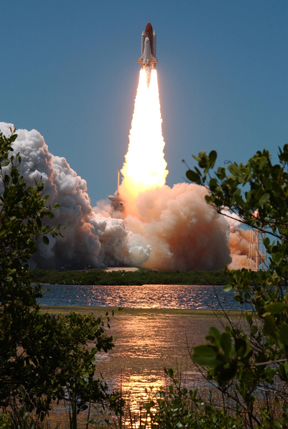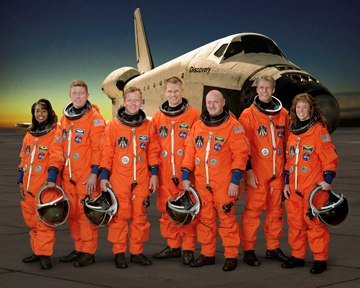|
Web Extra Wednesday, July 5, 2006
Shuttle liftoff, despite early snags
 After
two launch attempts were scrubbed due to weather concerns, the space shuttle
Discovery finally lifted off for the International Space Station
(ISS) with its seven-member crew at 2:38 p.m. on Tuesday, July 4 —
the first-ever shuttle launch on Independence Day.
After
two launch attempts were scrubbed due to weather concerns, the space shuttle
Discovery finally lifted off for the International Space Station
(ISS) with its seven-member crew at 2:38 p.m. on Tuesday, July 4 —
the first-ever shuttle launch on Independence Day.
The launch marks NASA's second shuttle mission since Columbia broke
apart upon reentry over Texas on Feb. 1, 2003, and the first since the
shuttle fleet was grounded last summer. The holiday launch went ahead
despite the discovery on Sunday evening of a crack in the foam insulation
of the shuttle's external fuel tank.
Space shuttle Discovery
lifts off for the International Space Station on July 4, making it the
the first shuttle to launch on Independence Day. Images courtesy of NASA.
The crew of the second "Return to Flight" mission, known as
STS-121, will test new procedures and equipment designed to enhance the
safety of shuttle flights. The tests are part of a continuing analysis
of improvements originally implemented and tested on Discovery's
first Return to Flight mission in July of 2005 (see Geotimes,
July 2005).
The new procedures and equipment are aimed at addressing the shuttle's
recurring problem of shedding foam insulation from its external fuel tank
during launch. Falling foam was to blame for damaging Columbia's
protective heat shield, ultimately leading to its tragic explosion. Despite
efforts to correct the problem, however, Discovery also shed a
piece of foam during its first post-Columbia mission last year.
Although the foam did not damage the shuttle, NASA grounded the shuttle
fleet until now to study the problem further.
After thorough inspections on Monday, NASA officials determined the crack
in Discovery's foam insulation was not of sufficient concern to
call off the launch. Small pieces of foam did fall from the shuttle during
its launch Tuesday, but they broke off after a critical period —
about a minute and a half into the launch, says Robert Mirelson, a NASA
spokesperson. Hence, the falling foam posed less of a threat to the shuttle,
he says.
Still,
Mirelson says, "everything will be evaluated." Starting today,
Discovery's crew and the crew of the ISS are using photography
and videography to obtain "unprecedented coverage" of the shuttle
— part of the new safety improvements. NASA will then use the imagery
to examine the shuttle for anything that could "cause problems during
descent," Mirelson says — for instance, damage to areas such
as the shuttle's leading edge or wheel wells. Preliminary reports, however,
show no cause for concern.
 A
major objective of the STS-121 mission is to visit the ISS, onto which
Discovery will dock during the third of its 12 days in orbit. Discovery's
astronaut Thomas Reiter will join the current two-person crew aboard the
ISS and remain there for several months. Discovery crewmembers
will also perform maintenance on the ISS and deliver more than 28,000
pounds of equipment and supplies needed for future expansion of the orbiting
outpost.
A
major objective of the STS-121 mission is to visit the ISS, onto which
Discovery will dock during the third of its 12 days in orbit. Discovery's
astronaut Thomas Reiter will join the current two-person crew aboard the
ISS and remain there for several months. Discovery crewmembers
will also perform maintenance on the ISS and deliver more than 28,000
pounds of equipment and supplies needed for future expansion of the orbiting
outpost.
The crewmembers of Discovery's
STS-121 mission are (from left) Stephanie Wilson, Michael Fossum, Steven
Lindsey, Piers Sellers, Mark Kelly, Thomas Reiter and Lisa Nowak.
Expansion and completion of the ISS, targeted for 2010, is a critical
first step in President Bush's "Vision for Space Exploration."
The plan calls for a manned return to the moon by 2020, and subsequent
exploration of Mars and beyond (see Geotimes,
June 2004; and current print issue). The ISS
will support these goals by providing a place for researchers to study
the effects of space on astronaut health and capabilities. NASA anticipates
flying the space shuttle about 16 more times to finish assembly of the
ISS, after which the shuttle fleet will be retired in favor of a new Apollo-shaped
spacecraft that can carry humans to the moon and Mars (see Geotimes,
July 2006).
Mirelson says the STS-121 shuttle mission is critical for "evaluating
new shuttle processes" and "a key step" toward the space
program's future. "Every mission is a stepping stone," he says.
Jennifer Yauck
Links:
Discovery's
STS-121 mission
Geotimes, July
2006
"Jetting through space,"
Geotimes, July 2006
"Discovery returns
to flight," Geotimes online, Web Extra, July 26, 2005
"To Mars and beyond,"
Geotimes online, Web Extra, June 17, 2004

 Subscribe
Subscribe

